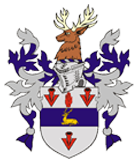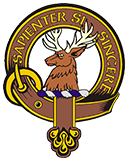Battles of Invernhaven And Perth – 1300s
Now, I suspect a number of you just said, “Wait a minute here, is he actually going to attack our esteemed Sir Walter Scott?” Well, yes and no. We all love Scott and cherish him as an icon of Scotland and Scottish heritage, no matter the country of our birth.

“Fair Maid” House in Perth
But, while we all love stories like Ivanhoe and Rob Roy, it must be recognized that Scott was, in fact, perhaps the equivalent of today’s Tom Clancy. Works by both authors contain realistic, semi-historic, or even a few accurate accounts and details, but the end products are/were intended to entertain and to skirt the boundary between fantasy and fact. Such is the case with the 1828 publication of The Fair Maid of Perth, the culprit behind the spread of erroneous Davidson histories. In the story, Scott uses the setting of the Battle of the North Inch – and even some of the real figures, who are then fictionalized for effect – to weave a tale of romance, intrigue, and excitement for the masses. However, so strong was the literary influence of this work and its writer on society that it was interpreted as accurately portraying the North Inch events, and its trappings found their way into the “historical facts” still held to by many to this day. But how on earth did this happen? After all, today’s Clancy fans are aware that, although some of the objects or events depicted in his stories are or were real, they are reading a work of fiction. This was not the case, however, in 19th century Scotland and England.
Since most of the rural population in Scott’s time were illiterate, published tales were often read aloud by the educated at public gatherings, complete with dramatic intonations and pause-for-effect deliveries. These readings were immensely popular and well attended. People spilled into the streets from the pubs, common houses, and other places they were held, and few missed an opportunity to be present. Specifically to the point, when these tales contained historical elements (and even when they didn’t), they were often taken as “news” rather than stories. Imagine now how someone might return home from business in city or town and re-tell these tales to their families and friends, filling in gaps where the original content could not be remembered; these telling the tales to their friends; these friends to others, and so on. This custom, folks, is how we end up with broken histories: one group having an account of an event that differs – even greatly at times – from that of another, yet with both having equal claim to it.
The practice is called “oral tradition” – a process whereby histories, tales, genealogies, and even recipes are handed down from generation to generation. It was a very typical and important process among illiterate and “pre-literate” peoples of the past, and is even still found in some societies of the present. Unfortunately, the level of embellishment that takes place within oral traditions is often on the extreme side. This is how an historical figure or event becomes an historical legend and then fades into grandiose myth. Deeds and exploits become more fantastic with each telling (“seven with one blow” ring a bell?). So again, the story of the Davidsons and the North Inch as we hear it now is more than likely not the same as when it was first crafted.

